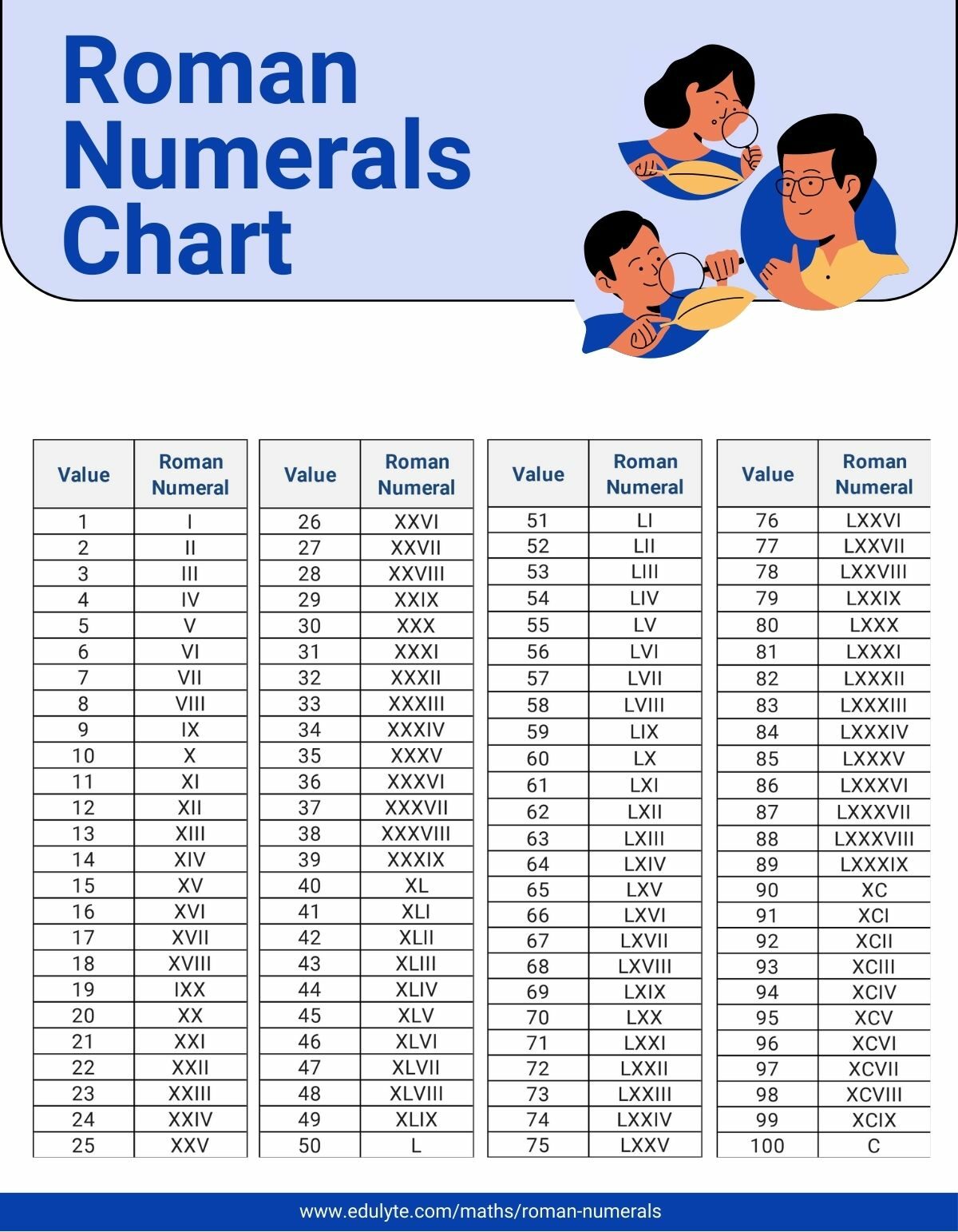Roman Numeral 5 The Mighty V :Demystifying 5...
Read More
Roman Numerals 1 to 100: Explore the Roman numeral system and unlock its secrets.
Comprehensive Definition, Description, Examples & Rules
Learning to write and understand Roman numerals 1 to 100 can be both practical and fascinating. Explore the first 100 Roman numerals and discover their patterns and intricacies with Edulyte.
Roman Numeral Converter
Refer to our Roman numeral converter to quickly convert numbers into Roman numbers in an error-free way.
What are Roman Numerals?
Roman numerals are a number writing system that originated in ancient Rome and were used throughout the Roman Empire and Europe well into the Middle Ages. They are represented by a series of letters and symbols, including I, V, X, L, C, D, and M, which are used to describe different numbers. Despite being replaced by the Arabic numeral system in modern times, Roman numerals 1 to 100 remain an essential part of global cultural heritage. They are used in various contexts, from clock faces to book chapters.
Roman Numerals and Subtractive Notation
Roman numerals 1 to 100 can be written in subtractive notation to create more concise expressions. It is done by placing a smaller digit before a more significant number to indicate subtraction. For example, instead of writing “IIII” for 4, we can write “IV” by subtracting 1 from 5. Similarly, “IX” represents 9 by removing 1 from 10, and “XL” means 40 by subtracting 10 from 50. This system can be applied to any number, making it a practical and efficient way to write Roman numerals.
How to know which number to subtract?
In Roman numerals, subtractive notation involves placing a smaller numeral before a more significant digit to indicate subtraction. To know which number to subtract, you need to follow a simple rule: you can only subtract a power of ten (i.e., 10, 100, 1000) and only from the following two higher “place values”. So, for example, you can subtract 1 from 10 (IX) or 10 from 100 (XC), but you cannot subtract 1 from 5 or 10 from 50. It’s essential to remember that subtractive notation is used to create shorter expressions, but using it’s not always necessary.
Solved Examples of writing Roman Numerals 1 to 100
While writing Roman numerals from 1 to 100, you should follow the following rules:
- To write the number 36 in Roman numerals, you would use the symbols XXXVI. It is because the number 36 is made up of 30 (XXX) plus 5 (V) plus 1 (I).
- To write the number 89 in Roman numerals, you would use the symbol LXXXIX. It is because the number 89 is made up of 50 (L) plus 10 (X) plus 10 (X) plus 1 (I) plus 1 (I) plus 1 (I).
Remember, when writing numbers in Roman numerals 1 to 100 , it’s essential to follow the rules and conventions of the system. These rules include using subtractive combinations (e.g. IV for 4 instead of IIII) and writing symbols in decreasing value order. However, you can become proficient at writing even complex numbers in Roman numerals with practice.
The are some helpful examples of how to write numbers in Roman numerals 1 to 100 :
- 42: XLII (this is the “Answer to the Ultimate Question of Life, the Universe, and Everything” according to Douglas Adams’ book “The Hitchhiker’s Guide to the Galaxy”)
- 100: C (this is the Roman numeral for “centum,” meaning one hundred)
Roman Numerals 1 to 100 Chart
Here is the chart of Roman numerals from 1 to 100:
| Roman Numeral | Value |
| I | 1 |
| II | 2 |
| III | 3 |
| IV | 4 |
| V | 5 |
| VI | 6 |
| VII | 7 |
| VIII | 8 |
| IX | 9 |
| X | 10 |
| Roman Numeral | Value |
| XI | 11 |
| XII | 12 |
| XIII | 13 |
| XIV | 14 |
| XV | 15 |
| XVI | 16 |
| XVII | 17 |
| XVIII | 18 |
| IXX | 19 |
| XX | 20 |
| Roman Numeral | Value |
| XXI | 21 |
| XXII | 22 |
| XXIII | 23 |
| XXIV | 24 |
| XXV | 25 |
| XXVI | 26 |
| XXVII | 27 |
| XXVIII | 28 |
| XXIX | 29 |
| XXX | 30 |
| Roman Numeral | Value |
| XXXI | 31 |
| XXXII | 32 |
| XXXIII | 33 |
| XXXIV | 34 |
| XXXV | 35 |
| XXXVI | 36 |
| XXXVII | 37 |
| XXXVIII | 38 |
| XXXIX | 39 |
| XL | 40 |
| Roman Numeral | Value |
| XLI | 41 |
| XLII | 42 |
| XLIII | 43 |
| XLIV | 44 |
| XLV | 45 |
| XLVI | 46 |
| XLVII | 47 |
| XLVIII | 48 |
| XLIX | 49 |
| L | 50 |
| Roman Numeral | Value |
| LI | 51 |
| LII | 52 |
| LIII | 53 |
| LIV | 54 |
| LV | 55 |
| LVI | 56 |
| LVII | 57 |
| LVIII | 58 |
| LIX | 59 |
| LX | 60 |
| Roman Numeral | Value |
|---|---|
| LXI | 61 |
| LXII | 62 |
| LXIII | 63 |
| LXIV | 64 |
| LXV | 65 |
| LXVI | 66 |
| LXVII | 67 |
| LXVIII | 68 |
| LXIX | 69 |
| LXX | 70 |
| Roman Numeral | Value |
| LXXI | 71 |
| LXXII | 72 |
| LXXIII | 73 |
| LXXIV | 74 |
| LXXV | 75 |
| LXXVI | 76 |
| LXXVII | 77 |
| LXXVIII | 78 |
| LXXIX | 79 |
| LXXX | 80 |
| Roman Numeral | Value |
| LXXXI | 81 |
| LXXXII | 82 |
| LXXXIII | 83 |
| LXXXIV | 84 |
| LXXXV | 85 |
| LXXXVI | 86 |
| LXXXVII | 87 |
| LXXXVIII | 88 |
| LXXXIX | 89 |
| XC | 90 |
| Roman Numeral | Value |
| XCI | 91 |
| XCII | 92 |
| XCIII | 93 |
| XCIV | 94 |
| XCV | 95 |
| XCVI | 96 |
| XCVII | 97 |
| XCVIII | 98 |
| XCIX | 99 |
| C | 100 |
More about Roman Numerals
Get more information about Roman numerals by clicking on the links below:
Roman Numerals 4
Roman Numerals 4 Cracking the Code: How to...
Read MoreRoman Numerals
Roman Numerals Unlocking the Secrets of Roman Numerals...
Read MoreConclusion
Roman numerals 1 to 100 may seem like a relic from the past, but they are still relevant today—moreover, their knowledge is significant for maths students.
If you’re struggling with Roman numerals or any other aspect of maths, consider signing up for maths classes by the best tutors from across the globe. Edulyte’s live classes are flexible and fully personalised to meet your learning needs.Our expert tutors can help you master maths fundamentals and build the skills you need to succeed in school and beyond. So why wait? Sign up for Edulyte today and start your journey to maths mastery!

Step Up Your Math Game Today!
Free sign-up for a personalised dashboard, learning tools, and unlimited possibilities!

Frequently Asked Questions
The Romans did not have a numeral to represent zero.
Roman numerals are still used today for various purposes, such as in clock faces, book chapters, movie credits, and even in some legal documents. They are also used as a decorative element in modern design.
The basic rules of writing Roman numerals include using a combination of seven letters to represent different values, such as I for 1, V for 5, X for 10, L for 50, C for 100, D for 500, and M for 1,000. Additionally, the numerals are typically written from left to right in descending order of value.
To convert a Roman numeral to a modern-day number, assign each numeral its corresponding value and add or subtract them as necessary. For example, the numeral IX represents the value of 9, which is obtained by subtracting I (1) from X (10).
The Roman numeral for 50 is “L”.
The Roman numeral for 100 is “C”.
The Roman numeral for 99 is “XCIX”.
The Roman numeral for 500 is “D”.
The Roman numeral for 1000 is “M”, the Roman numeral for 900 is “CM”, and the Roman numeral for 90 is “XC”. So, 1990 in Roman numerals would be “MCMXC”.
The Roman numeral for 4 is “IV”.
The fundamentals of Mathematics taught are the foundations for your college education and future career. Therefore, receiving the proper guidance and absorbing the knowledge is crucial. Go through our tutor listings and their courses. Find one that suits your requirements and ensure a good academic result!
You can reschedule your lessons. However, we recommend talking to your teacher at least 24 hours before your scheduled lesson to do so. For more details, please refer to the cancellation policy.
Our trainers will assess your current level of Mathematics and suggest the best activities and topics to begin with, in the class. Then, they will fine-tune the syllabus and resource materials to customise them for you.
It all comes down to the time you spend with the subject, how much you practise regularly, and what kind of guidance you get from your teachers. Our tutors patiently encourage you by pointing out errors that you make and suggest ways to stop repeating them.




